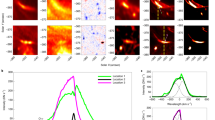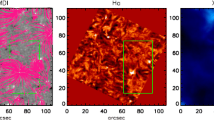Abstract
We study the response of the chromosphere and transition region to dynamic changes in the photospheric network magnetic fields. We present results from simultaneous measurements taken by TRACE in chromospheric and transition region (C iv) images, high-resolution magnetograms taken by MDI, and spectra of chromospheric (C ii) and transition region lines (O vi) obtained with the SUMER instrument on SOHO. Enhanced emission in the C iv line is generally co-spatial with the magnetic pattern in the photosphere. We propose a mechanism of electro-mechanical coupling between the photosphere and upper layers of atmosphere based on hydrodynamic cumulation of energy produced by reconnecting flux tubes in the photosphere/chromosphere region (Tarbell et al., 1999). We believe that a basic process causing energetic events is the cascade of shock waves produced by colliding and reconnecting flux tubes. The continuous supply of flux tubes in the ‘magnetic carpet’ ensures the ubiquitous nature of this process and its imprint on the upper atmosphere. The appearance of bright transients often, but not always, correlates with canceling mixed polarity magnetic elements in the photosphere. In other cases, transients occur in regions of unipolar flux tubes, suggesting reconnection of oblique components. Transients are also seen in regions with no fields detected with the MDI sensitivity; these may be reconnections of tiny features with diameters less than 100 km. Blinkers and other bright transients are often accompanied by two directional plasma jets. These may be generated by cylindrical self-focusing of shock fronts or by collision of shocks produced by neighboring reconnection processes. The observations suggest that stronger emissions correspond to lower velocity jets, and vice versa; this property is a natural consequence of the proposed mechanism. Plasma flows are always seen whenever the slit crosses strong magnetic flux tubes or vertices of converging flows in the supergranular network. The overall energy distribution between heating and plasma flows is an intrinsic feature of our mechanism.
Similar content being viewed by others
References
Berger, T. and Title, A.: 1996, Astrophys. J. 463, 365.
Berger, T. E., De Pontieu, B., Schrijver, C. J., and Title, A. M.: 1999, Astrophys. J. 519, L97.
Brekke, P., Hassler, D. M., and Wilhelm, K.: 1997, Solar Phys. 175, 349.
Coppi, B., Rosenbluth, M. N., and Sudan, R.: 1969, Ann. Phys. 55, 201.
Dere, K. P.: 1994, Space Sci. Rev. 70, 21.
Dere, K. P., Bartoe, J.-D. F., and Brueckner, G. E.: 1989, Solar Phys. 123, 41.
Dere, K. P., Bartoe, J.-D. F., Brueckner, G. E., Cook, J.W., and Socker, D. G.: 1988, Solar Phys. 114, 223.
Dikasov, V. M., Rudakov, L. I., and Ryutov, D. D.: 1965, Soviet Phys. JETP, 21, 1965.
Dodd, R. K., Eilbeck, J. C., Gibbon, J. D., and Morris, H. C.: 1982, Solitons and Nonlinear Wave Equations, Academic Press, London.
Guderley, G.: 1942, Luftfahrtforschung 19, 302–312.
Handy, B. N., Bruner, M. E., Tarbell, T. D., Title, A. M., Wolfson, C. J., Laforge, M. J., and Oliver, J. J.: 1998, Solar Phys. 183, 29.
Harrison, R. A. et al.: 1997, Solar Phys. 170, 123.
Harvey, K. and Harvey, J.: 1973, Solar Phys. 28, 61.
Innes, D. E., Brekke, P., Germerott, D., and Wilhelm, K.: 1997, Solar Phys. 175, 341.
Kadomtsev, B. B., Mikhailovski, A. B., and Timofeev, A. V.: 1964, Soviet Phys. JETP 20, 1517.
Kjeldseth-Moe, O., Brynildsen, N., Brekke, P., Engvold, O., Maltby, P., Bartoe, J.-D. F., Brueckner, G. E., Cook, J. W., Dere, K. P., and Socker, D. G.: 1988, Astrophys. J. 334, 1066.
Kjeldseth-Moe, O., Brynildsen, N., Brekke, P., and Maltby, P.: 1994, Space Sci. Rev. 70, 89.
Landau, L. D. and Lifshits, E. M.: 1987, Fluid Mechanics, Pergamon Press, Oxford.
Mariska, J. T.: 1992, The Solar Transition Region, Cambridge University Press, Cambridge.
Moses, D. et al.: 1994, Astrophys. J. 430, 913.
Ostrovski, L. A., Rybak, S. A., and Tsimring, L. Sh.: 1986, Soviet Phys. Usp. 29, 1040.
Petschek, H. E.: 1964, NASA Spec. Publ., SP-50, p. 425.
Petviashvili, V. and Pokhotelov, O.: 1992, Solitary Waves in Plasmas and in the Atmosphere, Gordon and Breach, Philadelphia, PA.
Ryutova, M. P.: 1988, Soviet Phys. JETP, 67, 1594.
Ryutova, M. and Sakai, J.: 1993, JETP Lett. 58, 507.
Ryutova, M. P. and Habbal, S. R.: 1995, Astrophys. J. 451, 381.
Ryutova, M., Shine, R., Title, A., and Sakai, J. I.: 1998, Astrophys. J. 492, 402.
Schrijver, C. J. et al.: Solar Phys. 187, 261.
Sturrock, P. A.: 1960, J. Appl. Phys. 31, 2052.
Sturrock, P. A.: 1966, Phys. Rev. Lett. 16, 270.
Tarbell, T., Ryutova, M., Covington, J., and Fludra, A.: 1999, Astrophys. J. 514, L47.
Title, A.M. and Schrijver, C. J.: 1997, in R. Donahue and J. A. Bookbinder (eds.), Cool Stars, Stellar Systems, and the Sun, Astron. Soc. of the Pacific Conf. Series.
Wikstol, O. et al.: 1997, in A. Wilson (ed.), Proc. of 5th SOHO Workshop, The Corona and Solar Wind near Minimum Activity, ESA SP-404, ESA, Noordwijk, p. 733.
Author information
Authors and Affiliations
Rights and permissions
About this article
Cite this article
Tarbell, T., Ryutova, M. & Shine, R. Electro-Mechanical Coupling Between the Photosphere and Transition Region. Solar Physics 193, 195–218 (2000). https://doi.org/10.1023/A:1005234807433
Issue Date:
DOI: https://doi.org/10.1023/A:1005234807433




